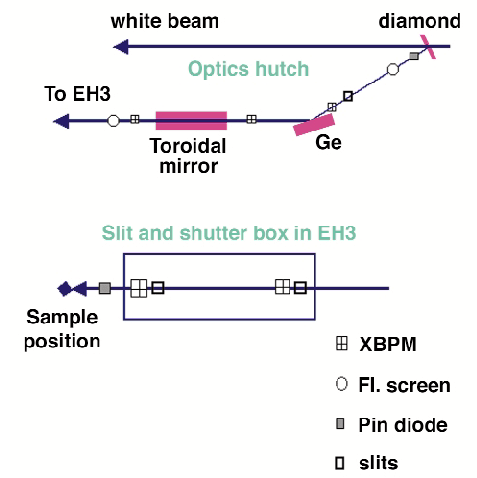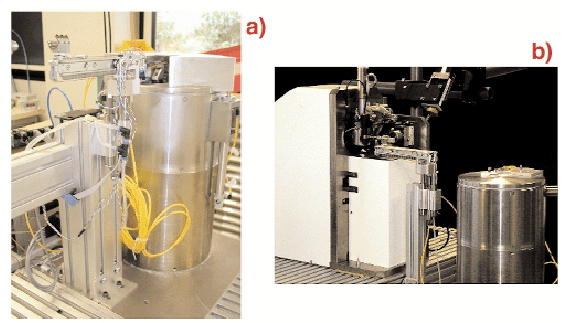- Home
- Users & Science
- Scientific Documentation
- ESRF Highlights
- ESRF Highlights 2002
- Macromolecular Crystallography
- Beamline Automation - Why and How?
Beamline Automation - Why and How?
Progress report by J.E. McCarthy and S. Arzt (ESRF)
The advent of recombinant gene technology and protein expression systems combined with the publication of genome sequences for many organisms, including H. sapiens and many of his pathogens, has led to a surge in the number of macromolecular structures to be studied. X-ray crystallography is the dominant technique used in the determination of the three-dimensional structures of macromolecules and third-generation synchrotron sources such as the ESRF are already proving of great benefit in the rapid collection of X-ray data from macromolecular single crystals. In the current era of structural genomics it is important that the structure-determination process occurs as rapidly as possible and modern synchrotron macromolecular crystallography (MX) has evolved into an efficient pipeline of sample screening and subsequent data collection, reduction and phasing at the beamline [1]. However, when carried out manually, this process has many bottlenecks, which will become increasingly evident as crystal production becomes more efficient. Automation is therefore an essential step in ensuring that macromolecular structure solution becomes a very high throughput process.
Automation of a synchrotron MX experiment may be divided into two areas; data collection and data processing, and beamline alignment and stability. Data collection automation should include processes for sample mounting/dismounting, aligning and screening, whilst automation of data processing needs to address image indexing and integration, data reduction, phasing, map calculation and model building. Beamline alignment automation should ensure that the users have access to a beam that is stable in both intensity and position during their experiments, without having to carry out manual alignment procedures. All of the aspects described above have been addressed in the automation program currently being undertaken at the ESRF by the JSBG.
For beamline alignment, a system of X-ray beam position monitors (XBPMs) will be used to constantly track both the position and intensity of the X-ray beam. The positions of the XBPMs and other diagnostic tools are shown in Figure 15 for the newly refurbished ID14-3 beamline. The monitored values will be stored in a database along with motor and encoder positions, and will be used for constant feedback and auto-regulation of the beamline components.
 |
|
Fig. 15: Outline of automation diagnostics on the refurbished beamline ID14-3. Information concerning the X-ray beam position will be constantly monitored using the XBPMs. This will be used along with monitored values of all motor and encoder positions for constant feedback and auto-regulation of the beamline components. |
Mounting and alignment of pre-cryocooled samples into the X-ray beam will be done using an automatic sample changer and micro-diffractometer (Figure 16), both developed by the JSBG. The sample changer will allow storage and automatic mounting/dismounting of up to 50 crystal samples. The micro-diffractometer allows visual monitoring of the X-ray beam and can automatically centre micro-crystals accurately in the X-ray beam. Prototypes of both the sample changer and the micro-diffractometer have been successfully tested and will be installed on selected ESRF MX beamlines within the coming year.
 |
|
Fig. 16: (a) The automatic sample changer and (b) the micro-diffractometer. |
Automatic screening of crystals as well as data processing will be handled by the DNA project [2], an inter-facility project involving scientists from ESRF, SRS Daresbury and the MRC-LMB. The system characterises each sample by analysing test images to determine crystal and data quality. If these are acceptable, a strategy for optimum data collection is proposed then followed (including integration etc), otherwise the sample changer is activated to mount a new crystal and the screening procedure repeated. In this way, the DNA software will supervise simultaneously data collection and processing. Automation of information management uses PXWEB, a Web-based database combining information from the ESRF User Office with a local experimental database. Users may enter and access information about the crystal samples, view/edit reports about collected data, monitor current data collections with access to images and reexamine previously collected data.
The ESRF's first fully-automated MX beamlines, ID14-3 and ID23, are under construction and are expected to take users during 2003.
References
[1] E.P. Mitchell, Nucl. Instr. and Meth. A. 467-468, 1372-1374 (2001).
[2] A.G.W. Leslie, H.R. Powell, G. Winter, O. Svensson, D. Spruce, S. McSweeney, D. Love, S. Kinder, E. Duke and C. Nave, Acta Cryst. D 58, 1924-1928 (2002).
Principal Publication and Authors
J.E. McCarthy and S. Arzt.
ESRF



